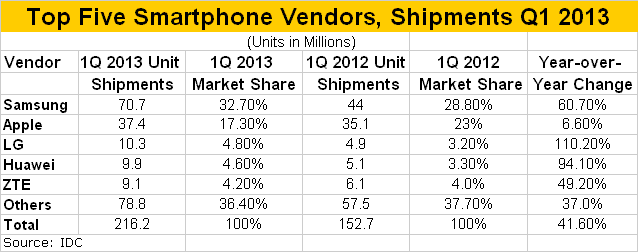Media twits, little and big, are getting their jetties (knickers) in a twist over Apple’s rumored plans to launch a larger screen iPhone.
Apple is said have asked its suppliers in Asia to provide prototypes of screens larger than 4-inches.
Over the last two months, there have been media reports of Apple introducing a 4.7-inch smartphone and another with a 5.7-inch screen.
The current generation iPhone 5 has a 4-inch screen while the older iPhone 4 and 4S that Apple is still peddling have 3.5-inch screens.
Apple co-founder Steve Jobs once declared the 3.5-inch screen “the perfect size for consumers.”
Until the iPhone 5 debuted last year, five generations of iPhones (original iPhone, iPhone 3G, 3GS, 4 and 4S) stuck to Jobs’ recommended 3.5-inch screens.

My Experience
I’ve used 3.5-inch iPhones for over five years and never felt constrained by the screen size.
Hey, it’s a mobile device that goes into your pocket or handbag, not a 27-inch wide-screen iMac.
So keep your expectations realistic.
Does Size Matter?
Now, is a larger screen iPhone that big a deal?
No!
Apps, processor speed, dropped calls, innovative features and price should be the determining factors for a smartphone. As screen sizes increase, battery life too becomes a bigger headache.
In my view, Apple is looking at larger screens for future iPhones prompted by fears that consumers are bewitched by and defecting to its principal rival Samsung Galaxy S4’s 5-inch screen.
Apple is panicking and suffering from the me-too syndrome that until recently plagued its Android rivals.
Samsung Galaxy S4 is probably the first smartphone Apple has had to compete with on the buzz factor.
Starting with a glitzy launch in New York City in March, Samsung has done a remarkable job on marketing the Galaxy S4.
Although S4 sales are slowing, the phone has managed to find favor with consumers.

In recent quarters, Apple’s share of the smartphone has been declining while that of Samsung rising.
In the first quarter of 2013, Samsung’s smartphone marketshare was 32.7% while Apple has fallen to 17.3%.
Just three years back, iPhone was the largest selling smartphone.
Clearly, Apple is under tremendous pressure to stem the marketshare decline of its cash-cow iPhones.
A battle Apple is unlikely to win.
Key Problem
The major problem facing Apple vis-a-vis the declining marketshare of iPhone is pricing.
Apple is an obscenely greedy company with a ravenous appetite for high operating profit margins.
The company was fortunate to enjoy big operating margins on the iPhones until recently.
But it is the fate of consumer electronics companies that prices fall quickly and cheaper and more nimble rivals rise up to throw the gantlet at the established player.
If Apple wants to keep iPhone prices at current levels and still tempt consumers to buy them, then the innovation gap between Apple and its rivals has to be very, very large. That’s not happening since Android has considerably bridged the chasm with Apple’s iOS mobile operating system.
Second, in countries like the U.S., Apple’s penetration of the smartphone market is already pretty high thanks to subsidized phones from carriers like AT&T and Verizon. These are mature markets and the opportunity for future growth are low.
Third, in a lot of countries the iPhone is not subsidized and consumers must pay full price for the device.
In fast-growing markets like India, Brazil and China, paying an obscene amount like $649-$849 for a smartphone is unimaginable for hundreds of millions.
In India, Apple sales have been falling after a spurt in the fourth quarter of 2012 driven by discounts and installment schemes.
IDC estimates that in the first quarter of 2013 Apple sold 120,000 iPhones in India, down 48% from the 230,000 in Q4 of last year. This means Apple’s marketshare of smartphones in India has fallen from 4.7% to 2.1%.
Smartphone vendors like Samsung, Micromax and Karbonn that run on the Android software are eating Apple’s breakfast, lunch and dinner in India.
I reckon the picture can’t be all that different in China and Brazil.
Bottom line, an increase in screen size is not going to work miracles for Apple.
Sure, the Apple fanboys will gush over it and snap it up. But that’s not a big enough market for a company of Apple’s size.
Only lower prices will help Apple to stem the decline in overall marketshare and expand its presence in the high-growth nations like China, India, and Brazil.
Even if Apple introduces a cheaper plastic iPhone targeted at developing countries, can their prices match the Android smartphones like Micromax and Karbon?
The short answer – No!
Growth prospects for the iPhone are not attractive unless Apple drops prices big time, which the company will never do.

I suspect Apple’s third quarter (results coming tomorrow) hasn’t been all that attractive to the company from the perspective of iPhone sales. This is a bad trend that can only worsen in the coming quarters.
Besides the high price, there’s also the issue of carrying around the larger screen iPhones.
I struggle to carry my 3.5-inch iPhone 4 (enclosed in a Ballistic case).
A 4.7-inch or 5.7-inch iPhone will only make my plight, and that of millions, worse.
My prediction is that history will repeat itself and Apple will slowly become a niche player in smartphones. Not too long ago, the Mac was a niche player after Windows conquered the desktop world.
Get ready for Apple’s share price to plunge further, in the vicinity of $200!

You must be logged in to post a comment Login